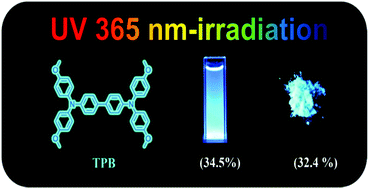Novel electrochemical devices with high contrast ratios and simultaneous electrochromic and electrofluorochromic response capability behaviours†
Abstract
In this work, we studied the novel redox-active material N,N,N′,N′-tetrakis(4-methoxyphenyl)-1,1′-biphenyl-4,4′-diamine (TPB) and found it to exhibit the crucial optical characteristics of high PL quantum yields both in solution (ΦPL = 34.5%) and solid (ΦPL = 32.4%) states. This unique PL characteristic was key for fabricating liquid-type and gel-type electrochemical devices displaying high-performance electrochromic (EC) and electrofluorochromic (EFC) behaviours at the same time. All of the obtained devices based on TPB exhibited excellent EFC performance, including rapid switching response times, unprecedented PL intensity contrast ratio (Ioff/Ion) values of up to 374 (the highest value reported to the best of our knowledge), and remarkable levels of electrochemical stability. In addition, these devices could, without UV irradiation, be transformed between being highly transparent and colourless devices and being truly black ones through switching between their original and oxidative states.



 Please wait while we load your content...
Please wait while we load your content...